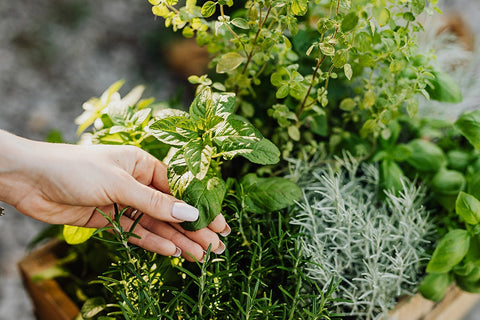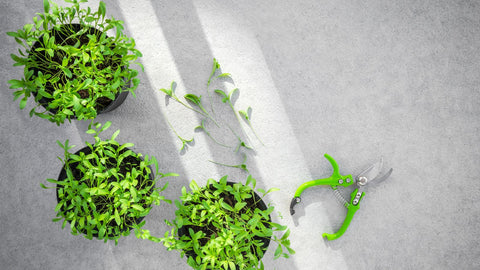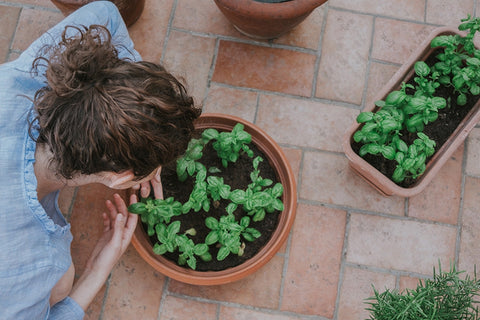Caring for Multiple Herbs in One Pot
Now that you've decided to grow a mixed herb container, you're probably ready for the next step... learning how to care for it!
Wait, you can plant more than one type of herb in the same container? YES! Learn how: Can You Plant Multiple Herbs In One Pot? Here's The Answer

What Size and Type of Container?
A container that is 18-inches in diameter will nicely fit a mixed herb garden. For dwarf herbs like thyme and dwarf basil, smaller pots in the 10- to 15-inch range work well. Long balcony or patio planters also make great options for side-by-side herb companions.
We highly recommend using containers with a self-watering reservoir or pots with drainage holes and water-catching trays.
What Type of Planting Mix or Soil Should You Use for Your Herbs?
When potting up a mixed herb garden, look for organic herb and vegetable potting mixes, premium potting mix labeled for edibles, or a mix formulated for outdoor containers. These usually contain organic compost, coir, composted bark, and ideally some composted worm castings or another natural source of nutrients. These mixes retain enough moisture and drain well for all your herbs. For moisture-sensitive herbs, consider mixing in a little extra expanded shale or LECA.
How Much Light Do You Need for Your Herbs?

When growing outdoors, you generally need about six hours of direct sunlight to grow herbs, although some, especially Mediterranean herbs like rosemary, oregano, sage, basil, and thyme, prefer even more. Cooler temperature herbs like cilantro, parsley, dill, and mint tolerate less light and can still do well with 4-5 hours of direct light.
Even with a bright windowsill, most gardeners don't have enough natural light indoors for big herb harvests. Grow lights can provide ideal conditions if you’re ready to grow herbs indoors or want to start herb transplants indoors for your garden. If you’re not sure about your lighting situation, our lighting for indoor herbs blog has a straightforward guide to get you all set up.
How Much Water Do You Need for Your Herbs?
Water needs can be tricky to get right, especially as a novice gardener. That’s why we recommend using self-watering planters because they make your life so much easier. However, some tips to keep in mind are to let the soil dry slightly between waterings for Mediterranean herbs and maintain moisture in the soil at all times for moisture-loving herbs.
Pinching and Pruning Your Herbs
Of course, we can’t forget about pinching and pruning our herbs. Pinching and pruning are more than just for maintaining aesthetics and keeping your plants looking nice and clean. Snipping your herbs at the right time will enable you to continually produce all the herbs you need and maximize your tiny herb garden. If you want to know more about pruning your herbs, read this detailed guide on pruning.









There are no comments for this article. Be the first one to leave a message!